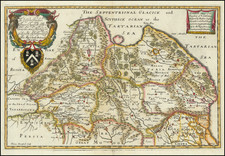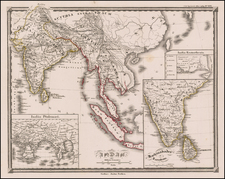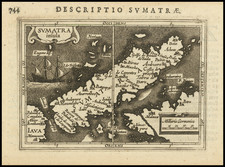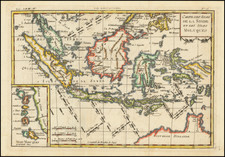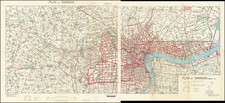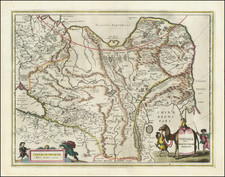Striking early view of Macao, from volume 8 of De Bry's Petit Voyages.
The main buildings and sites of the Portuguese settlement at Macao are visible in this rare, early view.
Macao, the first European colony in China, was established by the Portuguese in about 1557, at the south-west entrance to the Pearl River estuary. Macao quickly became a strategic stronghold for European voyages and remained a principal focal point of European voyages in the Far East and Pacific. The settlement derived its name from the Chinese goddess Ama, whose Temple is depicted here as the three-windowed circular building just to the left of the upper centerfold.
In this view, Macao is shown from the adjacent Lappa island and is built around the central square of La Misericordia, where the prominent crucifix is clearly visible. The inhabitants are seen going about their daily business loading ships and fishing, with merchants being carried in jiaos (sedan chairs) or under the shade of large umbrellas borne by their servants.
Theodor de Bry (1528-1598) was a prominent Flemish engraver and publisher best known for his engravings of the New World. Born in Liege, de Bry hailed from the portion of Flanders then controlled by Spain. The de Brys were a family of jewelers and engravers, and young Theodor was trained in those artisanal trades.
As a Lutheran, however, his life and livelihood were threatened when the Spanish Inquisition cracked down on non-Catholics. De Bry was banished and his goods seized in 1570. He fled to Strasbourg, where he studied under the Huguenot engraver Etienne Delaune. He also traveled to Antwerp, London, and Frankfurt, where he settled with his family.
In 1590, de Bry began to publish his Les Grands Voyages, which would eventually stretch to thirty volumes released by de Bry and his two sons. The volumes contained not only important engraved images of the New World, the first many had seen of the geographic novelties, but also several important maps. He also published a collection focused on India Orientalis. Les Grands Voyages was published in German, Latin, French, and English, extending de Bry’s fame and his view of the New World.









